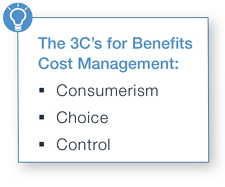Nine powerful strategies to help you get health care costs under control.
*An excerpt from the eBook
As organizations look at their balance sheets this year, one
area that will undoubtedly undergo intense scrutiny is the cost of
employee benefits. It is a notoriously difficult item to manage due to
the increasing cost and utilization of health care, not to
mention ACA compliance burdens. Human resources and finance managers
need to take a longer view and commit to developing a multi-year
strategy instead of relying on short-term tactics to contain employee benefits costs.
A multi-year plan incorporates plan design, administration,
funding, contribution, and health management strategies to deliver
savings on the cost of employee benefits of up to 30 percent.
It
all begins with the three C’s
Depending on your organization’s goals, you may focus on a
specific aspect of cost management when re-aligning your benefits plan.
An easy way to think about it is the three C’s of cost savings:
 Consumerism - Do you want your employees to be smarter health care consumers and make better decisions
that bring down the total cost of the benefits?
Consumerism - Do you want your employees to be smarter health care consumers and make better decisions
that bring down the total cost of the benefits?- Choice
- Do you want to offer more options in order to attract
and retain employees without increasing your total benefits
costs?
- Control - Do you want to reduce financial risk and create long-term, sustainable cost savings?
Building
a cost-effective benefits plan
Once you have determined your overall cost savings goal, there are
a number of ways to redefine the structure of your employee benefits
plan to better manage costs. Consider the following nine strategies:
High deductible – Potential savings: two percent through
lower annual premium increases. The high deductible health plan allows
employers to reduce costs while motivating them to carefully consider
how and when to access health care services.
Self-Funding – Potential savings: eight to nine percent
in annual premium increases. Growing increasingly popular even with
smaller organizations, self-funding allows businesses to create more
cost-efficient employee benefit programs.
Telehealth- Potential savings: 5-to-1 return on
investment. Telemedicine enables the delivery of care at a lower cost
than the traditional health care model and reduces unnecessary emergency
room visits and urgent care services.
Reference based
pricing– Potential savings: Up to 20 percent of total medical
claims. Reference-based pricing promotes comparison shopping by
establishing caps for selected services that have a wide-range of prices
from providers.
Voluntary
benefits– Potential savings: reduction of the annual eight to nine
percent premium increases down to zero percent. Voluntary benefits
supplement fixed plan options and can include hospital-stay expense
coverage, dental, vision, disability, life insurance and more.
Pharmacy
benefits management– Potential savings: 20 percent for an expense
that typically comprises 20 percent of overall health care costs. To
curb the steep rise in pharma costs in recent years, a pharmacy contract
management company can re-negotiate new terms, including better
contract provisions,
discounts and rebates.
Narrow networks – Potential savings: six to 17 percent
annually versus a total network of providers. Under narrow network
plans, 99 percent of health care costs are covered when in-network
providers are utilized. These providers have track records for the
highest
quality of care and have proven over time to deliver it at a lower
cost.
Defined medical
contribution– Potential savings: five to 10 percent savings on
annual premium increases. This strategy allows organizations to directly
manage costs and encourage employee plan selection and ownership. It
can be coupled with an employer exchange shopping technology solution or
steering employees toward a public
exchange environment.
Metallic spectrum
product plan– Potential savings: avoid the $3,000 per eligible
employee penalty the IRS will levy on non-compliant affordable plan
options. Multi-plan benefits options or a metallic spectrum of plans –
silver, gold, platinum – is a way of serving a wide range
of employee needs, budgets and concerns and reducing the potential
of over-insuring the healthiest employees.
Ultimately
better benefits management
While each of these strategies holds the promise of lowering the
cost of your benefits plan, the key is finding the ones that best suit
your organization’s culture and employee needs. For a more in-depth look
at employee benefits cost management,
download the full e-book and contact a HUB International advisor today.